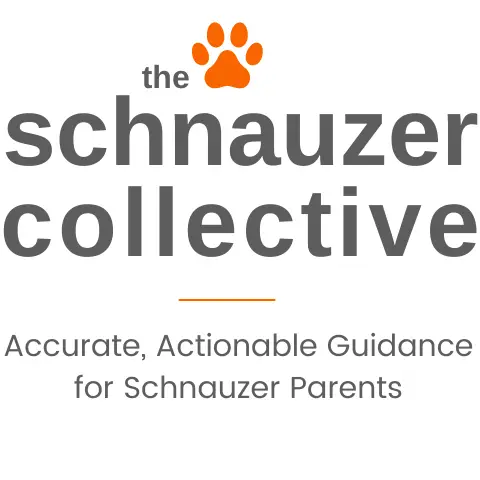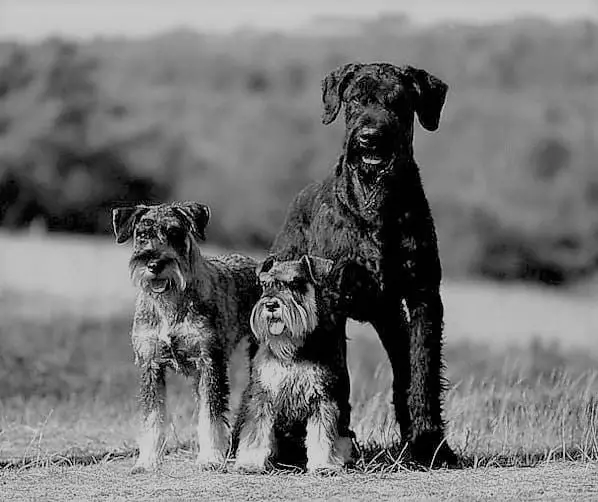When we were looking for a good family pet, we knew that it needed to be manageable, good with kids, and hypoallergenic for my sensitive mom. We decided that a Schnauzer might be a good fit for us, but we then wondered if there might be several varieties and sizes of Schnauzers we should know about.
Indeed, there were.
So, just how many Schnauzer varieties are available? There are three sizes and varieties of the pure Schnauzer breed: Giant, Standard, and Miniature. The varieties are primarily listed and identified by size. However, while size is a defining aspect of each variety, there are subtle yet important differences among them, and you’ll want to consider more than just size when making your decision.
So, if size isn’t the only difference among the three varieties, what else should you know before deciding which variety would make the best companion for you and your family? Let me share the information we took into consideration as we were making that decision for ourselves.
Why are There Three Schnauzer Breeds and Why Does it Matter?
There are three varieties of the Schnauzer breed simply because the Standard Schnauzer was cross-pollinated with other dog breeds. The new varieties were created for very specific purposes in early German farming life and were bred to create characteristics needed for weather, farming, and temperament purposes.
Knowing some good information about each variety matters because it will influence your choice. The sheer size difference between each variety is only one consideration. The very deliberate cross-breeding involved in creating each variety has resulted in some differences you should know about.

Here is some brief background on each of the Schnauzer varieties:
| Standard | The Standard Schnauzer is the original variety of Schnauzer and originated in Germany during the 14th or 15th They were originally bred to catch rats and serve as guard dogs. |
| Giant | During the 17th century, Standard Schnauzers were cross-bred with larger breeds such as Great Danes, German Shepherds, Rottweilers, and Dobermans to create the much larger Giant Schnauzer. This variety was bred specifically for guarding farms and to drive livestock. |
| Miniature | The Miniature Schnauzer is the most recent variety. This variety resulted from Standard Schnauzers being cross-bred with Affenpinsche and Miniature Poodle to create a breed that would also catch small rodents and serve as a small guard dog. |
Each Schnauzer variety shares some consistent characteristics. For example, they are each considered to be intelligent dogs that enjoy activity, entertainment, and engagement. On the physical front, their coats are distinctive and similar, and feature hair rather than fur.
However, because each of the Schnauzer varieties was created through combining very different breeds, their temperament can also vary. In addition to temperament and personality, their training needs, exercise and activity needs, along with their maintenance and health considerations all vary to some degree. They each share Standard Schnauzer genes, and that gives each variety a lot of consistency, but there are differences to be aware of….some of which we will explore below:
The Original Breed: Standard Schnauzers

As I mentioned above, Standard Schnauzers are the original and oldest variety of Schnauzer.
Standard Schnauzers can vary in height from 17.5 to 19.5 inches at the shoulder, vary in weight between 30 to 50 pounds, and enjoy a life span of between 13 to 15 years.
The Standard Schnauzer’s coat should be brushed about twice per week with regular grooming every six to eight weeks to maintain their distinctive look.
Their original German breeders were hard-working landowners and expected the same work ethic from their dogs. Standard Schnauzers were trained to catch small animals, hunt, and guard the family land.
Standard Schnauzers still maintain their original, hard-working characteristics and should be kept active in as many ways as possible. They are great companions for daily runs, hikes, and walks. Any type of activity will keep Standard Schnauzers happy since they were bred for work. Take them out to “work” in the garden with you, travel on family trips, and play with the kids.
Standard Schnauzers are also highly intelligent and can become bored if they are not engaged with an activity. The are quick to learn new sports, tricks, and games.
As with all Schnauzers, Standard Schnauzers combine their intelligence with independence and can be somewhat stubborn. They can be trained to be the type of companion you need, though. Start early and be consistent with teaching them to stay with you and use their energy constructively. For example, sport or trick training will keep them busy learning new skills and using their intelligence in novel ways.
Standard Schnauzers can also become excellent therapy or service dogs. Once they are trained in basic socialization and meet any requirements, they (and you) can find fulfillment in helping others who need emotional support. The fact that they are essentially hypoallergenic and feature hair rather than fur is also a significant plus as a therapy or service dog. Check with your state’s therapy dog requirements as well as any requirements of organizations you want to work with.
If you need more information about Standard Schnauzers, you will want to read our Ultimate Guide.
The Largest Breed: Giant Schnauzers

As you can imagine even from their name, the Giant Schnauzer’s size, training requirements, and personality present a potentially larger-than-life reality for its caretakers.
First, the basics. Giant Schnauzers can vary in height from 23.5 to 27.5 inches at the shoulder, vary in weight from 65 to 110 pounds, and enjoy a life span of between 10 to 15 years.
Their sheer size alone could a factor in deciding if this is the right variety for you. If you have kids, this size of dog could easily overwhelm small children, but may be the perfect size for teens.
Giant Schnauzers can be a wonderful addition to any family. However, they aren’t necessarily the type of dog that likes to cuddle (and they can, in fact, be fairly stubborn and independent). They are quite territorial, and don’t necessarily warm up to other dogs or cats. On the other hand, Giant Schnauzers are loyal, loving guardians of their caretakers.
Remember, this variety was bred specifically to be a strong, independent, hard-working addition to challenging German weather, farming, and herding conditions. As a result, Giant Schnauzers are independent-minded dogs and should be trained consistently and early. They will need to know that you are in charge and will need to understand their role in your life and family.
Along those same lines, Giant Schnauzers are strong, hearty, active dogs and will need plenty of opportunity to “work.” Their genetic heritage predisposes them to need daily exercise, even vigorous activity such as playtime and running. They enjoy a large, fenced yard but are not really dogs that should be ignored or left alone outside. Even with their large size, they should live inside the family home.
As with all large dogs, especially with the Schnauzer beard and longer coat, there may need to be some cleanup after meals and walks. Their wiry coat should be brushed twice a week and regular grooming scheduled every six to eight weeks to maintain their distinctive look.
This can be a demanding Schnauzer variety that will require very early training, physical exercise, clean-up, and grooming. They are probably not a good fit for the first-time dog owner. However, as with all Schnauzer breeds, this is a solid family breed that will be a loving, loyal, protector of the entire house and everyone in it.
If you need more information about Giant Schnauzers, you will want to read our Ultimate Guide to Giant Schnauzers.
The Smallest and Most Recent Breed: Miniature Schnauzers

Miniature Schnauzers are the most recent variety of the Schnauzer breed and while they were originally bred to hunt rodents around a farm, they have become one of the most beloved and popular household companions.
Miniature Schnauzers range in height from 12 to 14 inches at the shoulder, vary in weight between 11 to 20 pounds, and enjoy a life span of between 12 to 15 years.
The Standard Schnauzer’s coat should be brushed about twice per week and regular grooming scheduled every six to eight weeks to maintain their distinctive look.
Miniature Schnauzers are also highly intelligent, entertaining, active dogs. While they are considered a small breed, they are not “lap dogs.” Quite the opposite, their genetic heritage and breeding leads them to need exercise and activity along with mental stimulation.
They can develop distinct personalities and quickly become part of the family. Miniature Schnauzers are great with children, particularly if they have grown up around kids. They love to play and interact with people, and they have a protective nature. They are small enough to be generally safe with young children, but also sturdy enough to enjoy a little rough-housing with older kids.
Miniature Schnauzers can be trained relatively easily if you start young and remain consistent. They are also intelligent enough to be trained well into adulthood.
Like all Schnauzers, they are fairly territorial but can be socialized early to do well with most people and other animals such as other dog breeds and even cats. However, because they were bred to prey on rodents, it is best not to leave them alone with very small pets such as gerbils and birds. Just saying.
When the topic of Schnauzer breeds comes up, there is always a lingering question about “toy” or “tea cup” Schnauzers. The reality is that these smaller dogs are miniature Schnauzers that have simply been bred extra small. They are tiny dogs that are growing in popularity.
However, “toy” or “tea cup” Schnauzers are not officially recognized as a distinct Schnauzer breed and the practice of breeding them has become slightly controversial. Of course, there is nothing wrong with purchasing a smaller version of the Miniature Schnauzer just be aware that you will probably pay a premium price for the size.
All in all, Miniature Schnauzers are a loving, intelligent, protective, and fun companion. They are a terrific addition to any family.
If you need more information about Miniature Schnauzers, you will want to read our Ultimate Guide.
Related Questions:
Are Schnauzers Hypoallergenic? Each Schnauzer variety is considered to be hypoallergenic because they have hair rather than fur. While all dogs shed to some degree, Schnauzers shed very, very little. Because they are covered in hair, they contain far less dander and result in little to no allergic reaction in most people. In addition, Schnauzers don’t drool much and this reduces the chance for allergic reaction (and clean-up) even more.
Are Schnauzer Coats Hard to Take Care of? One characteristic that sets this breed apart is its double coat. Schnauzers have a soft, dense undercoat that grows close to the skin, and a wiry outer coat. Long, soft hairs called feathers grow on the dogs’ legs. Schnauzers will benefit from a good brushing a couple of times a week, and a professional grooming every 6 weeks. Regular brushing will also help to keep the Schnauzer’s skin healthy and it is also a nice way to bond with your dog.
And finally, from one pet parent to another, discover my all-time favorite resources designed to cover your every Schnauzer need. I’ve done the legwork for you so you can spend more time with the people and fur friends in your life.
A portion of all profit earned on this site is donated to Pet Partners
whose mission is to improve human health and
well-being through the human-animal bond.
They train and register pets to become therapy animals,
and have local chapters in many states.


